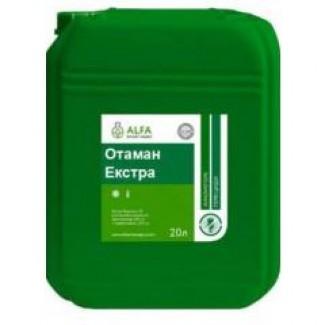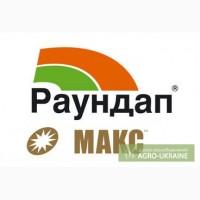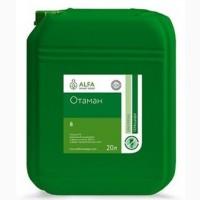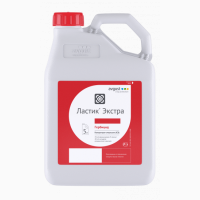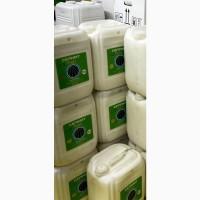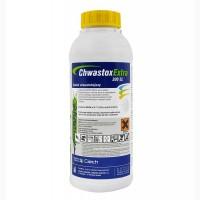Sell / buy
Otaman Extra herbicide, Kharkov region.
Price5250 UAH.
Region:all of Ukraine,
Kharkiv region.
Updated :
Active substance
Glyphosate acid, 540 g/l (in the form of potassium salt)
Preparative form
Soluble concentrate
Appointment
Modern systemic herbicide-desiccant continuous action based on the potassium salt of glyphosate
Tara
20 l
Culture
Advantages(//tractor-service.com)
Fast and more complete penetration into weed plants due to the highest solubility among other glyphosate salts.
Better efficiency in cool and dry conditions.
Extremely fast herbicidal action.
No restrictions on crop rotation.
Mechanism of action
The mechanism of herbicidal action consists in inhibiting the biosynthesis of aromatic amino acids, in particular phenylalanine and tyrosine. At the ultrastructural level, there is destruction of chloroplast membranes, swelling of the endoplasmic reticulum, and progressive disintegration of membranes. The herbicide contributes to the accumulation of ammonia in the green parts of plants, which is a strong cellular poison.
Properties
The drug is characterized by a low level of foaming when preparing the working solution. This property is very relevant when using the drug by the method of small-volume spraying.
General recommendations
For best results, apply when weeds are in active growth under favorable weather conditions. The optimal phase of weed development for processing: perennial grasses - 4-5 leaves (10-15 cm), perennial dicotyledons - rosettes of 10-20 cm, annual grasses - at least 5 cm leaf length, annual dicotyledons - 2-3 real leaves Apply in dry and windless weather no later than 2-3 hours before rain. During spraying, do not allow the herbicide to get on the leaves of cultivated plants, trees and bushes. Do not use Otaman Extra herbicide in conditions of prolonged drought. The herbicide can be mixed with other commonly used pesticides on appropriate crops. However, in each case it is necessary to check the drugs for compatibility. To enhance the herbicidal effect on weeds less sensitive to glyphosate, in particular, perennial dicotyledons, use a tank mixture: Otaman Extra (2-3 l/ha) + Alpha-Dicamba (0.2 l/ha).
The rate of consumption of the working fluid is 150-250 l/ha. =otzyvy, info.
Glyphosate acid, 540 g/l (in the form of potassium salt)
Preparative form
Soluble concentrate
Appointment
Modern systemic herbicide-desiccant continuous action based on the potassium salt of glyphosate
Tara
20 l
Culture
Advantages(//tractor-service.com)
Fast and more complete penetration into weed plants due to the highest solubility among other glyphosate salts.
Better efficiency in cool and dry conditions.
Extremely fast herbicidal action.
No restrictions on crop rotation.
Mechanism of action
The mechanism of herbicidal action consists in inhibiting the biosynthesis of aromatic amino acids, in particular phenylalanine and tyrosine. At the ultrastructural level, there is destruction of chloroplast membranes, swelling of the endoplasmic reticulum, and progressive disintegration of membranes. The herbicide contributes to the accumulation of ammonia in the green parts of plants, which is a strong cellular poison.
Properties
The drug is characterized by a low level of foaming when preparing the working solution. This property is very relevant when using the drug by the method of small-volume spraying.
General recommendations
For best results, apply when weeds are in active growth under favorable weather conditions. The optimal phase of weed development for processing: perennial grasses - 4-5 leaves (10-15 cm), perennial dicotyledons - rosettes of 10-20 cm, annual grasses - at least 5 cm leaf length, annual dicotyledons - 2-3 real leaves Apply in dry and windless weather no later than 2-3 hours before rain. During spraying, do not allow the herbicide to get on the leaves of cultivated plants, trees and bushes. Do not use Otaman Extra herbicide in conditions of prolonged drought. The herbicide can be mixed with other commonly used pesticides on appropriate crops. However, in each case it is necessary to check the drugs for compatibility. To enhance the herbicidal effect on weeds less sensitive to glyphosate, in particular, perennial dicotyledons, use a tank mixture: Otaman Extra (2-3 l/ha) + Alpha-Dicamba (0.2 l/ha).
The rate of consumption of the working fluid is 150-250 l/ha. =otzyvy, info.
|
Автор, контакты | |
Ольга Іванівна / отзывы, инфо. / activity evaluation | |
|
Phone:
+380xxxxxx
show|| |195
| |
ID объявления: #1245209
(added by a registered user, registration date: 11-10-2022)
Added/Updated: 08-09-2024 13:09 (current, until: 09-08-2025)
Permanent ad address:
Showed / watched for today: ?, total: ?
Similar ads
Among them there are many interesting...
